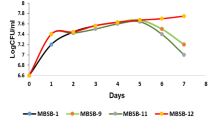Abstract
Bisphenol-A is one of the highest volumes of chemicals produced worldwide and released into the atmosphere each year. Recent extensive literature has raised concerns about its possible endocrine-disrupting effect in animals and humans. A bacterium having high tolerance of bisphenol-A (1000 mg L−1) was isolated from agriculture soil of Coimbatore District, Tamil Nadu, India, and identified as Virgibacillus sp. KU4 by 16S ribosomal RNA sequence analysis. Bisphenol-A removal efficiency of this strain was measured as greater than 92% at seventh day of incubation in a basal mineral medium supplemented with 1000 mg L−1 at seventh day. Gas chromatography analysis showed that 1000 mg L−1 BPA in distilled water was degraded by the Virgibacillus sp. KU4 in an efficient way. A 70 ± 3% bisphenol-A degradation was observed in the suspended cell pellet-mediated degradation study, where distilled water supplemented with 1000 mg L−1 bisphenol-A was sole carbon and energy source for bacterial growth. Further, Virgibacillus sp. KU4 is expected to be a candidate as a biological cleaner of BPA in the environment.



Similar content being viewed by others
References
Arboleda C, Cabana H, De Peril E, Jones P, Jimenez G, Mejia A, Agathos S, Penninckx M (2013) Elimination of bisphenolA and triclosan using the enzymatic system of autochthonous Colombian forest fungi. ISRN Biotechnol 2013:1–12
Braun JM, Kalkbrenner AE, Calafat AM, Yolton K, Ye X, Dietrich KN et al (2011) Impact of early-life bisphenol A exposure on behavior and executive function in children. Pediatrics 128(5):873–882
Cajthaml T, Zdena K, Katerina S, Monika M (2009) Biodegradation of endocrine-disrupting compounds and suppression of estrogenic activity by ligninolytic fungi. Chemosphere 75(6):745–750
Dorn PB, Chou CS, Gentempo JJ (1987) Degradation of bisphenol A in natural waters. Chemosphere 16(7):1501–1507
Fischer JU, Kappelmeyer M, Kastner F, Schauer H, Heipieper J (2010) The degradation of bisphenol A by the newly isolated bacterium Cupriavidus basilensis JF1 can be enhanced by biostimulation with phenol. Int Biodeterior Biodegrad 64(4):324–330
Fujiwara H, Soda S, Fujita M, Ike M (2016) Kinetics of bisphenol A degradation by Sphingomonas paucimobilis FJ-4. J Biosci Bioeng 122(3):341–344
Garbeva P, Van Veen JA, van Elsas JD (2004) Microbial diversity in soil: selection microbial populations by plant and soil type and implications for disease suppressiveness. Annu Rev Phytopathol 42:243–270
Geens T, Goeyens L, Covaci A (2011) Are potential sources for human exposure to bisphenol A over looked? Int J Hyg Environ Health 214(5):339–347
Kamaraj M, Rajeshwari S, Venckatesh R (2014) Biodegradation of bisphenol A by the tolerant bacterial species isolated from coastal regions of Chennai, Tamil Nadu, India. Int Biodeterior Biodegrad 93:216–222
Kang JH, Kondo F (2002a) Bisphenol A degradation by bacteria isolated from river water. Arch Environ Contam Toxicol 43(3):265–269
Kang JH, Kondo F (2002b) Effects of bacterial counts and temperature on the biodegradation of bisphenol A in river water. Chemosphere 49(5):493–498
Kang JH, Ri N, Kondo F (2004) Streptomyces sp. strain isolated from river water has high bisphenol A degradability. Lett Appl Microbiol 39(2):178–180
Kang JH, Katayama Y, Kondo F (2006) Biodegradation or metabolism of bisphenol A: from microorganisms to mammals. Toxicology 217(2–3):81–90
Khursheed AW, Rajni Y, Shivom S, Krishan KU (2014) Comparative study of physicochemical properties and fertility of soils in Gwalior, Madhya Pradesh. World J Agric Sci 10(2):48–56
Lobos JH, Leib TK, Su TM (1992) Biodegradation of bisphenol A and other bisphenols by a gram-negative aerobic bacterium. Appl Environ Microbiol 58(6):1823–1831
Masuda M, Yamasaki Y, Ueno S, Inoue A (2007) Isolation of bisphenol A-tolerant/degrading Pseudomonas monteilii strain N-502. Extremophiles 11(2):355–362
Michałowicz J (2014) Bisphenol A—Sources, toxicity and biotransformation. Environ Toxicol Pharmacol 37(2):738–758
Rezg R, El-Fazaa S, Gharbi N, Mornagui B (2014) Bisphenol A and human chronic diseases: current evidences, possible mechanisms, and future perspectives. Environ Internat 64:83–90
Rochester JR (2013) Bisphenol A and human health: a review of the literature. Reprod Toxicol 42:132–155
Rogers JA, Metz LV, Yong W (2013) Review: endocrine disrupting chemicals and immune responses: A focus on bisphenol-A and its potential mechanisms. Mol Immunol 53(4):421–430
Rubin BS (2011) Bisphenol A: an endocrine disruptor with widespread exposure and multiple effects. J Steroid Biochem Mol Biol 127(1–2):27–34
Sakai K, Yamanaka H, Moriyoshi K, Ohmoto T, Ohe T (2007) Biodegradation of bisphenol A and related compounds by Sphingomonas sp. strain BP-7 isolated from seawater. Biosci Biotechnol Biochem 71(1):51–57
Spivack J, Leib TK, Lobos JH (1994) Novel pathway for bacterial metabolism of bisphenol A. J Biol Chem 269(10):7323–7329
Sun Q, Li Y, Chou PH, Peng PY, Yu Ch P (2012) Transformation of bisphenol A and alkylphenols byammonia-oxidizing bacteria through nitration. Environ Sci Technol 46(8):4442–4448
US Environmental Protection Agency (2011) Testing of Bisphenol A: advance notice of proposed rulemaking. Fed Regist 76:44535–44547
vom Saal FS, Akingbemi BT, Belcher SM, Birnbaum LS, Crain DA, Eriksen M et al (2007) Chapel Hill bisphenol A expert panel consensus statement: integration of mechanisms, effects in animals and potential to impact human health at current levels of exposure. Reprod Toxicol 24(2):131–138
Wang L, He XB, Li FH, Liu C (2005a) A serological survey of Bisphenol A in Shenzhen City. Preven Med 12:241–242
Wang XJ, Zhang YM, Li HS, Duan ZW, Cui JS (2005b) Study of bisphenol A on reproductive and developmental toxicities in mice. Chin J Occup Med 32:37–39
Zhang C, Zeng G, Yuan L, Yu J, Li J, Huang G, Xi B, Liu H (2007) Aerobic degradation of bisphenol A by Achromobacter xylosoxidans strain B-16 isolated from compost leachate of municipal solid waste. Chemosphere 68(1):181–190
Acknowledgement
We are thankful to Karpagam University, Coimbatore, Tamil Nadu, India, for providing the necessary laboratory facilities for this work.
Author information
Authors and Affiliations
Corresponding author
Additional information
Editorial responsibility: J Aravind.
Rights and permissions
About this article
Cite this article
Kamaraj, M., Rajeshwari, S. & Aravind, J. Isolation of Virgibacillus sp. strain KU4 from agricultural soil as a potential degrader of endocrine disruptor bisphenol-A. Int. J. Environ. Sci. Technol. 15, 2545–2550 (2018). https://doi.org/10.1007/s13762-017-1398-8
Received:
Revised:
Accepted:
Published:
Issue Date:
DOI: https://doi.org/10.1007/s13762-017-1398-8




